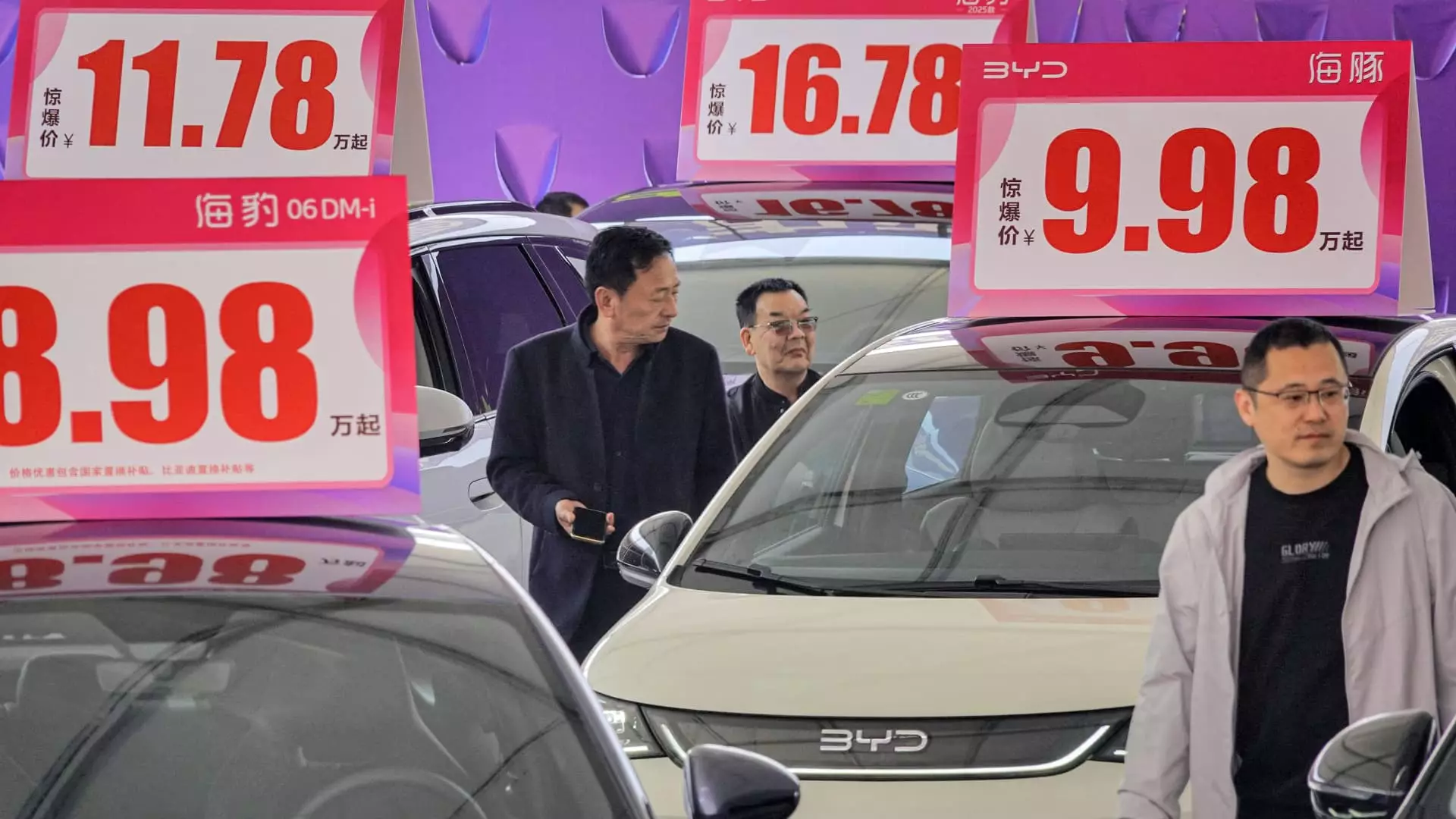In a move that has sent shockwaves throughout the electric vehicle (EV) landscape, BYD, a titan in the Chinese auto industry, recently unveiled aggressive price reductions—some discounts soaring as high as 30%. Such drastic measures are not merely a marketing tactic; they signify a seismic shift in a market that has only recently begun to stabilize. The implications are vast, extending from China’s domestic economy to the global auto sector, and sharpening the competitive edge that the EV market has long enjoyed amidst slower economic growth and slacking consumer demand.
The compact Seagull, once a modest offering, has emerged as a symbol of this fierce competition, with its price slashed to approximately 55,800 yuan, or $7,750. Such affordability threatens to undermine not just the pricing strategies of domestic rivals but also the notion of sustainability in the burgeoning electric vehicle arena. Analysts like Zhong Shi have noted that this wave of price cutting has left smaller automakers reeling, amplifying fears over their viability in a market that is evolving at lightning speed.
The Domestic Economy: A Double-Edged Sword
China’s economic narrative has been precarious of late, and while the EV sector has been a clarion call of hope amidst the gloom of other industries, the current price war underscores an unsustainable reliance on aggressive discounting as a means to stimulate consumer spending. Morgan Stanley’s insights paint a grim picture—one where the continuous imbalance of supply and demand perpetuates deflationary pressures rather than fostering the rebalancing toward a more consumption-driven economy that policymakers have long envisioned.
What does this mean on the ground? For many consumers, it might signal a temporary reprieve, allowing access to cutting-edge technology and modern transportation at lower costs. However, this benefit is fleeting if it jeopardizes the very companies that could lead future innovation or even push manufacturers to cut corners in quality and safety standards just to remain competitive.
Echoes from the Real Estate Crisis
The echoes of previous economic crises loom large in this current situation. Great Wall Motors’ chairman even drew a chilling comparison to the Evergrande saga—a warning of potential impending chaos within the auto industry that mirrors the catastrophic fallout seen in real estate. With the fast-paced growth of EVs, a perilous bubble might be forming, reminiscent of the property market’s overheated trajectory prior to its collapse. The question remains: how prepared are these manufacturers to absorb the shock if demand suddenly stagnates?
Moreover, just as the real estate sector was scrutinized for outrageous debt levels and unsustainable practices, the electric vehicle market is now facing a similar examination as concerns rise about inflated vehicle prices and the longevity of their demand. BYD’s own financial struggles, including sharp increases in liabilities alongside higher net profits, signal a precarious balance between growth and stability.
A Diminishing Market Growth
Despite the fanfare surrounding the EV industry’s growth, it’s essential to recognize that double-digit increases in sales often come at the expense of traditional internal combustion engine vehicles rather than indicating true market expansion. The stagnation of the overall auto market since 2018, coupled with predictions of minimal growth in retail sales moving forward, raises serious questions about the sustainability of this ‘growth’ narrative.
Automakers appear trapped in a cycle of perpetual discounting to capture market share, which is not only detrimental to long-term profitability but can also lead to a race to the bottom, where quality becomes secondary to competition. Advanced technologies like driver-assist systems are now seen as necessary add-ons but should ideally be standard, blurring the lines of innovation in a desperate attempt to woo consumers.
Global Ramifications of National Strategy
As the traditional auto industry in China redefines itself, its ambitions have global ramifications. Calls for more substantial regulations to protect local automotive sectors in countries like the United States and those within the European Union are increasingly common. Tariffs and duties levied on Chinese-made electric vehicles illustrate mounting international tensions as regulatory bodies attempt to shield their markets from an surging influx of competitively-priced, state-subsidized vehicles.
However, the global fallout does not end there. The rise of brands like BYD in Europe, evidenced by outselling Tesla for the first time, further complicated the narrative, challenging established players in one of the world’s most lucrative automotive markets. It’s clear that this battle will not merely be confined to price; it will undoubtedly evolve into a struggle for quality, brand loyalty, and innovative edge as the automotive landscape transforms not just in China, but on a global scale.
While the aggressive tactics employed by BYD and other Chinese manufacturers may deliver short-term benefits for consumers, they raise pressing concerns about the broader implications for the industry’s ecosystem. The focus must shift from mere aggressive competition to fostering sustainable practices that guarantee innovation and viability for the future.

